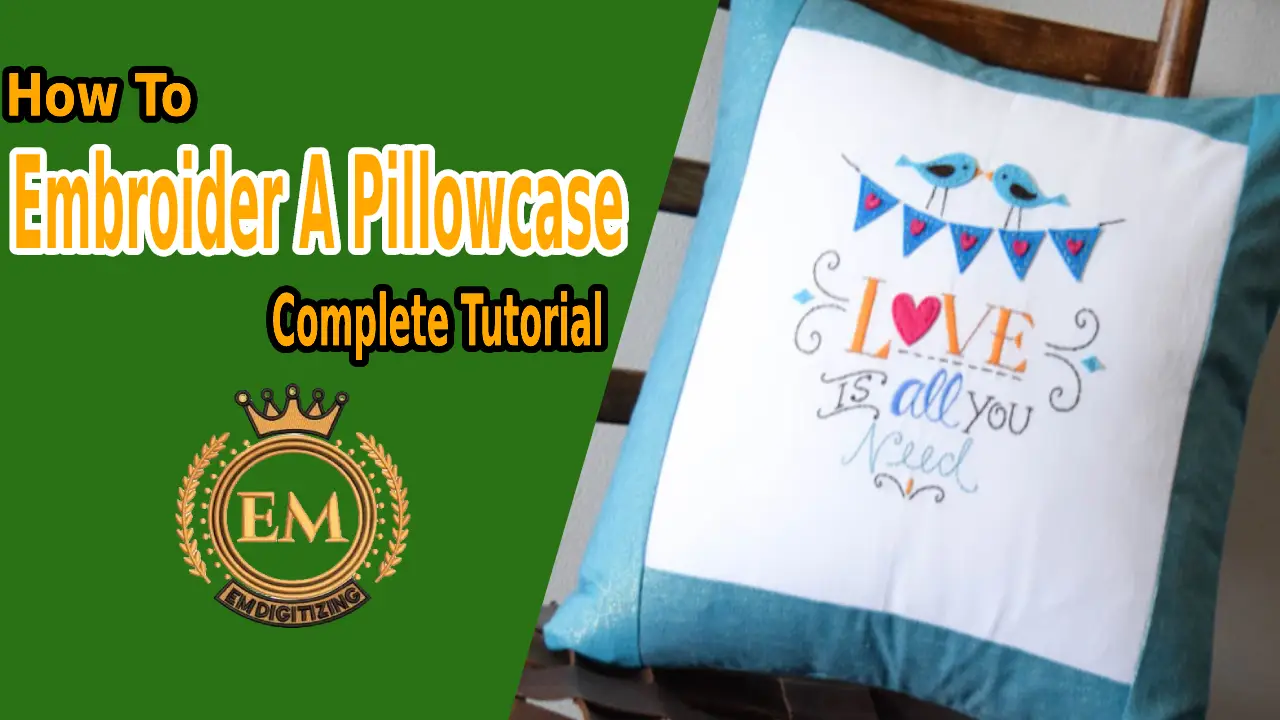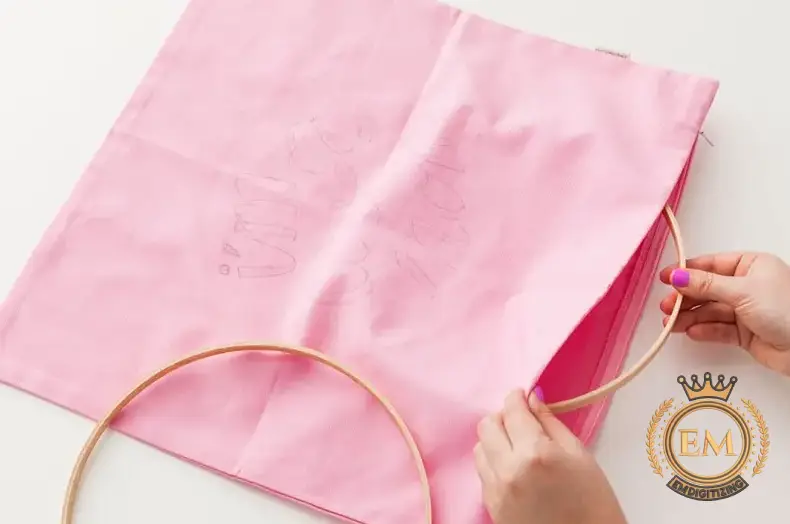Pillowcase embroidery is basically fribbling with a needle and thread. It’s amazingly simple, and it’s a vehicle for endless expression. Today I’m going to show you how to sew words onto a pillow, but you can use the same technique to sew a pineapple onto a tea towel, a spooky, see-through eye on the back of a cotton blouse, or practically Something else. Your heart desires! Well, anything made of cloth that belongs to you—Rookie doesn’t endorse the DORK factory you embroider on your school flag.
Given my bedtime-themed canvas, I thought a soft “sweet dreams” note would be a good choice. But whatever you choose for your pattern or message, all you need for this DIY is some basic, inexpensive supplies, a lot of patience (embroidery can take time!), and something you can sew. Have been wanting to make it 10,000,000% cute. Now, shall we? We will!

Embroidery Digitizing Services
Why Create & Embroider A Pillowcase?
Whether you’re switching up your pillow pattern for a modern living room beachy feel, or something cute for a little girl’s bed throw pillow, the change is easy. Changing the look can be as simple as changing the fabric and design you use. Determining which stabilizer to use with each fabric is easier than you think, just check out our complete guide to embroidery stabilizers.
When you make a new pillowcase, you can replace the original pillow, allowing you to change the tone of your room as many times as you like while on a budget.
Not only will you get to do something you know you’ll love and be unique, but you’ll also save money while doing it!
Supplies Required For Embroider A Pillowcase Project
- A set of 100% cotton pillows. Stretchier, less sturdy fabrics will make your stitches look sloppy and messy.
- Embroidery floss in at least two colors. I found mine here, but most local craft/sewing stores should have a good variety.
- A pencil.
- An iron.
- An embroidery hoop, like this. Wood or plastic is fine.
- Embroidery needles, like these. The eyes of these needles are larger than normal sewing needles to thread thick embroidery floss easily.
- Seam Reaper, like that.
Tutorial For Embroider A Pillowcase
Step 1:

Sketch out ideas for your design on paper so you know it will look good on your fabric. If you’re not confident in your freehand drawing skills, there are plenty of iron-on embroidery designs and alphabets available to help you out.
Step 2:

If you’re not using an iron-on design, iron your pillow beforehand. Wrinkled materials can be difficult to sew. Once I decided on my final design—the words Sweet Dreams in cursive with a few ’50s-style starbursts scattered around them—I drew them on the pillow in very light pencil so that when I If I sew, they will not be visible.
Step 3:
Fit the side of the pillow that you drew your design on (not both sides—you don’t want to sew it closed!) into the embroidery hoop, which pulls the fabric tight like a drum to give you a neat, clean look. Can be stitched. possible. The design may not fit at first, but that’s okay—you can readjust the hoop as you go.
Step 4:
Choose your first floss color and thread it through the eye of the needle. Before you start sewing, pull a decent length of floss from the spool—it’s always better to have more than you need, rather than halfway through and run out—and tie the ends into a tight knot.
Step 5:
 For this project, we’ll use a split stitch, which is the easiest to master and creates a nice, even line. As you will see, embroidery floss is made up of six strands. When you thread your needle, those six stitches go through the eye. When you pull your yarn up, those six strands come up too. But for a split stitch, separate these stitches by backstitching through each one after making them.
For this project, we’ll use a split stitch, which is the easiest to master and creates a nice, even line. As you will see, embroidery floss is made up of six strands. When you thread your needle, those six stitches go through the eye. When you pull your yarn up, those six strands come up too. But for a split stitch, separate these stitches by backstitching through each one after making them.
Step 6:
Now it’s time to make your first stitch! In this tutorial, we’re going to refer to the side of the pillow where the design appears as the “front” and the side where we’ll tie our knots as the “back.” (I realize this is very technical and scientific language, but I trust your intelligence). Starting at one end of your design (for me it was the first S), pull the needle back and bring the floss to the front. Continue this stitch, sewing through each previous stitch as you move along your line, split stitch style.
Step 7:
As long as you’re going with a continuous line in the same color, keep going until the line ends. Since the S in my first word wasn’t connected to wet, I tied the floss in the back when I was done with the first letter, and started over with the rest of the word. It’s easy: once you’ve hung your floss on the back of the fabric, divide your floss threads into two strands and tie them into a tight knot like you would for a shoelace. They do, but without a bow. , as often as you can.

Place the knots as close to the fabric as possible to ensure your design doesn’t unravel. You can use many colors of your choice. Just remember to start and end all your lines with back knots to save your hard work. If the back of your fabric starts to look like a total mess of knots, that’s okay! This is the front you want to look beautiful.
It’s also perfectly normal to make a stitch (or 10) that accidentally gets a little messy. If your design isn’t looking the way you planned, grab your seam ripper and slip it through the wrong stitch loop on the back of your material, then gently pull the floss out. Now you can try this part (after silently cursing yourself) without any damage. It can be disappointing but it happens to everyone!
Conclusion
Once you’re done, place this sucker on your bed and take a well-deserved beauty rest! When it comes time to wash them, your pillows should be able to withstand machine washing in hot water on the gentle cycle as long as you’re using 100% cotton fabric and tie your knots nice and tight. — Make sure not to use bleach. And wash them with similar colors for best results.
I’m pretty sure this is the cheapest daytime winter activity ever, so I highly encourage you to complete the cold, dreary days at embroidery parties! A warning, though: once you start, you might find yourself sewing everything in your wardrobe/wardrobe. For your own safety, maybe think twice before you decide to “customize” your mom’s newly reupholstered couch. Otherwise, have fun, and happy sewing!
Zigzag stitch
Remember to zigzag stitch (or use a serger) along the entire edge. After zigzagging the long side of the pillow, sew the ends of fabric A with a ¼” seam allowance, locking your stitching at both the beginning and end.
How to make a simple pillowcase.
- Step 1: Material cloth.
- Step 2: Create the Pattern Using an old pillow as a guide, measure the amount of fabric you need, making sure to leave 1 inch extra around the seam edges.
- Step 3: Sew the sewing.
- Step 4: Get Stitched.
- Step 5: You’re Done!
There is only one small difference between the two types of pillowcases – housewife’s pillowcases have sewn edges, which fit neatly around the pillow, while Oxford pillowcases have fabric around the edge. has a border. It’s as simple as that!
A traditional pillow is open at the end. An envelope pillow has a special envelope closure at the end so the pillow can be tucked in and out of sight while you make your bed. The envelope closure looks as good as it looks sounds.
Oxford pillows and housewife pillows have the same internal dimensions but there is a small difference. Oxford pillowcases have a wide stitched hem around the edge to create a border, usually between 5-10cm. The housewives pillow has a stitched edge that fits well with the pillow.
